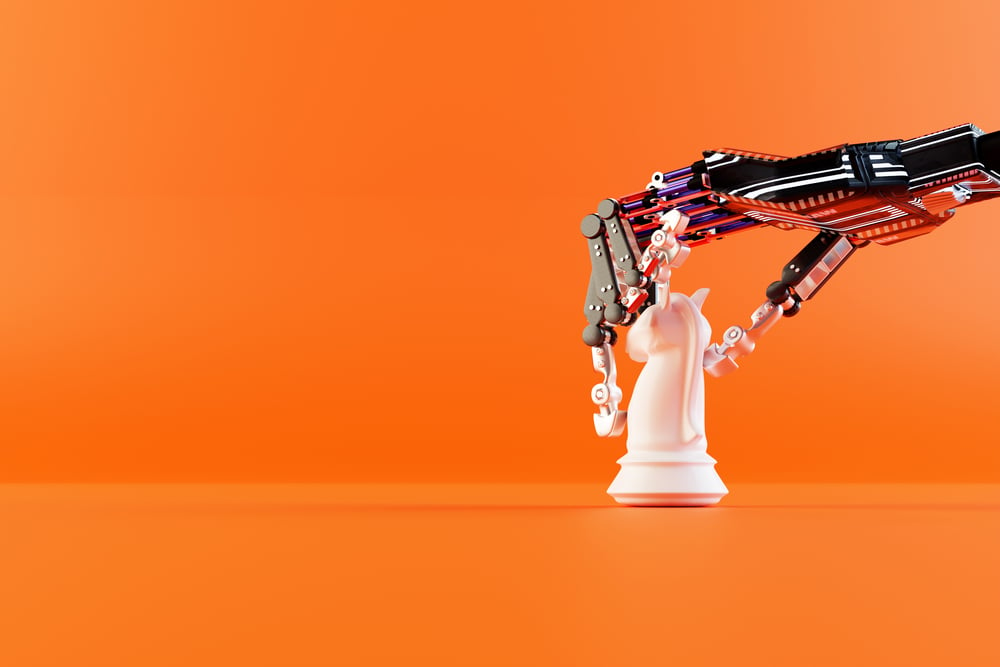Over the last two years, I have been working alongside GPT as a team. It has added and increased my abilities and helped me double my efficiency at work. Yes, before ChatGPT became publicly available, I built my own GPT copilot setup with various Python applications and integrations, bringing automation to the next level.
Now, all the examples below can be executed without any extra automation setup. By reading about my experience, you can see how I use GPT throughout the day and the process I follow to succeed with it. This might give you insights into how you or your team can leverage AI to increase personal or business productivity.
Adopting the best mindset
To get the utmost from GPT, we need to ask the right questions. I have a method that works well for me. My approach to not miss out on any of the brewing potentials with GPT consists of three stages:

First step: Self-deception – imagination is the only limitation
I begin by imagining GPT as a fully-fledged Artificial General Intelligence (AGI), possessing limitless capabilities, reasoning, and providing answers to any query. This mindset allows me to believe in its potential and push its boundaries. It is important to not set up false boundaries based on assumptions about what you can do together with GPT.
Second step: Challenging tasks – anything is possible
Next, I challenge GPT with ambitious tasks, anything from finding a cancer cure, tackling long-standing problems, or assisting with intricate mundane chores that would otherwise consume hours of my time.
Third step: Reality check – become the owner of the result
Finally, I return to reality, recognizing that GPT is merely a Language Model that generates responses based on statistics. I then carefully analyze and selectively scrutinize the results, learning from both successes and failures.
Prompting is the key to success
It is important to understand that to achieve good collaboration with anyone, AI and humans alike, we need good communication. This is even more so the case when speaking to GPT. The art of perfecting a solid conversation with GPT is called prompting. Even though I have had lengthy conversations with GPT-like models over the years, it never stops to amaze me how different responses I get, given the input I provide. If you want to learn everything about prompting I would suggest either this online course ChatGPT Prompt Engineering for Developers - DeepLearning.AI or this opensource site Introduction | Learn Prompting: Your Guide to Communicating with AI covering the art of prompt engineering. Although I think good prompts are part of the success of getting good-quality responses out from GPT models today – I also think that the required level of good prompting will decrease over time. We will see that models will become better at understanding the natural language, and applications will use grounding techniques to enhance our communication seamlessly with the best prompts fitted for the model in use.

Here are my top five best tips to accomplish a good GPT dialogue using prompting:
1. Be specific and clear
When asking a question or giving a command, make sure your prompt is specific and clear. Ambiguous or vague prompts may lead to irrelevant or confusing responses. Clearly state your requirements and expectations to get the most accurate and helpful response.
In real-life scenarios, we are allowed more leniency in our communication because we have more senses to express communication. As of now, we only have text and images to communicate with GPT, which puts an extra demand on us to overcome the lack of expressions by being overly precise in our text.
2. Use context to help GPT understand
Providing context in your prompt helps GPT understand the background information and the purpose of your query. This can lead to more accurate and relevant responses. You can include a brief explanation or a short example to set the context. Guide it toward the kind of response you are looking for or the type of format you wish the response to be presented in.
3. Break down complex tasks
If you have a complex task or question, break it down into smaller, more manageable parts. This will make it easier for GPT to understand and respond to each part effectively. You can then combine the responses to address the overall task or question.
4. Use step-by-step instructions
For tasks that require a sequence of actions, provide step-by-step instructions in your prompt. This will guide GPT through the process and help it generate a more structured and coherent response.
5. Iterate and refine
Sometimes, GPT may not provide the desired response on the first attempt. In such cases, iterate and refine your prompt by rephrasing the question, providing more context, or asking for clarification.
This will help GPT better understand your requirements and improve the quality of the answers. Think of it as having a conversation with your colleague where you ask for alternative ideas based on additional input from previous answers. This will also improve the accuracy rate and help you see less hallucinations. Hallucinations are what the machine learning industry calls creative but incorrect responses from the Large Language Model, sometimes so convincing that it will trick you into thinking it is valid.
Working with GPT: Examples and applications
I am not only using the online version of GPT. I have created my own copilot GPT setup. I have built many Python applications where I utilize various GPT-like APIs such as OpenAIs GPT4, Dall-E, and whisper – to get the utmost result and minimize my required effort.
But you do not have to build your own Copilot setup like me, it works well enough copying texts back and forth between applications. We also see that many tools I am currently using are being integrated by several big software brands into the applications we are using daily. Microsoft are about to release GPT functionalities across all their applications. But regardless of easier access to tools – they do not work unless you use them.
Here are some examples of how I use GPT throughout the day
Text comparison and tutoring:
GPT assists me in comparing different texts, identifying similarities and differences, and providing tutoring on various subjects. You can ask it to compare to the input you provide in the prompt, and also to general information found on the Internet. Remember that ChatGPT’s knowledge cutoff date is September 2021. If you have a premium subscription with ChatGPT, you can take advantage of the beta functionalities of adding browsing plugin and use the internet to find information. It is also possible to use Bing chat feature, which is built on GPT.
Meeting preparation and translations:
I am also getting valuable support in preparing for meetings by generating agendas, summarizing key points, and translating documents into different languages.
Drafting a Functional Design Document (FDD), user stories, blogs and other specifications:
GPT can create these types of documents directly from workshop recordings, saving time and effort. It can also create documents directly from Teams recordings. I run my Python app and it extracts the transcripts using OpenAI whisper and produces text outputs which are sent to Azure DevOps API to create proposed user stories directly in my projects. This Python app gives me an additional step of automation and can easily be achieved without any extra custom applications following these steps:
- If you have a file with either video or audio, please use the transcribe-to-text feature in the Microsoft online Word version. This will give you all conversations as text. There are other services as well and with most video meeting applications such as Microsoft Teams, you can get the transcription to file directly after your meeting.
- Create a prompt asking for a summary and possible key takeaways depending on the type of document you are creating.
- Then prompt again to ask the output to be formatted as you wish including an example of headings and layout.
- Finally, copy the output into your favorite editor and complete the output by going through the text and adjusting it with your thoughts and commentary.
Analyzing, compiling, translating, improving, and checking documentation:
You can get valuable help streamlining these tasks, ensuring accuracy and consistency. Running documents through GPT as a final check is exceptionally valuable. This is in essence what I use my potential time savings for. Reiterate and improve the quality of my output. Let us make things even better and not just faster!
Generating reports from existing documentation:
GPT can quickly produce comprehensive reports, allowing me to focus on more critical tasks. Getting GPT to deliver the obvious report structure and the major takeaways saves me time to focus on what is important.
Writing emails and planning the day:
GPT offers valuable support in drafting professional emails and planning my day, even checking my schedule against project management tools like Dynamics 365 Project Operations Azure DevOps and Silverbucket time reporting tool. Allowing GPT access to the data will give you the possibility to report and compare. Just try to copy out all your weekly appointments from Outlook and ask it to come up with a more efficient plan.
Coding assistant together with Github Copilot:
GPT serves as a valuable coding assistant in combination with Github Copilot, helping me write and analyze code more efficiently. For more information about Github Copilot, please check out my blog here.
Creating diagrams, PowerPoints, icons, and other simple graphics:
It is possible to create diagrams directly in ChatGPT if you have a premium chat subscription and use the wolfram plugin or the ChatGPT code interpreter feature.
GPT helps me visualize complex ideas and present them in an easily digestible format. Yes, you can create diagrams, images, icons, etc., from text. Many formats support this. For diagrams, I often use mermaid. I ask GPT to create a mermaid diagram code from text which I then use in a mermaid editor to visualize the diagrams – very handy for those working with Azure DevOps. For other Azure DevOps tips using GPT please check out my blog ‘DevOps’ + ‘ChatGPT/AI’ = ‘TRUE’ – Magnus Oxenwaldt
Time tracking:
And here is a keeper for busy consultants who dislike reporting working hours. GPT creates export files that I can import directly into the company time tracking system. I tag my calendar appointments with project codes and ask GPT to produce a report that I import directly into the time reporting system.
The Matrix mindset
I see GPT as a tool to debug my interactions with the world and the ideas around me, like programming and coding my reality construct and the movie Matrix. I think of everything around me as code, and I integrate myself using my birth-given language instead of injecting a spike into the back of my brain.
GPT is a partner in crime, an old confidant, someone I don't necessarily trust in all things, but I rely on for constructive criticism and creative inspiration. It supports me with repetitive and mundane chores and teaches me that alternative viewpoints exist if we care to listen. However, I never delegate my beliefs or work entirely without funneling them through me. GPT empowers me, and we have been a working hybrid team for a long time. But I'm always in the lead… well, for now, at least :)
Next big change
The next version of GPT is expected to have additional multimodal capabilities such as audio and video. It is hard to even imagine such low boundaries between humans and machines.

What are some of the possible ramifications of GPT with audio and video?
Enhanced communication: With audio and video capabilities, GPT could understand and generate not only text but also spoken language and visual content. The speed in how we would communicate and the increased nuances of adding audio and video from voice and expression, would manifold the efficiency and result of our dialogue with GPT.
Creativity beyond image and text: The combination of text, audio, and video capabilities could open new possibilities for creative applications, such as generating music, creating video content, designing virtual environments, and more. This could revolutionize industries like entertainment, advertising, and gaming.
Real-time feedback: Multimodal GPT could be used to create interactive and engaging content, providing real-time feedback through audio and video. Instead of waiting for the text to prompt back, you might get interrupted by GPT asking for immediate clarifications, saving time from unnecessary dialogue.
Obviously, these multimodal capabilities raise many other issues such as ethical concerns, job displacement, and increased dependency on AI. But that must be another blog article.
The short conclusion is that I am more efficient and increasing my abilities
Integrating with GPT has been a transformative experience, allowing me to enhance my abilities and deliver on various work tasks more efficiently. By following the three stages of integration and embracing the Matrix mindset, I have successfully harnessed the power of GPT to enhance my productivity and creativity. As we continue to develop and refine AI technologies, the potential for even greater collaboration and growth is limitless.

